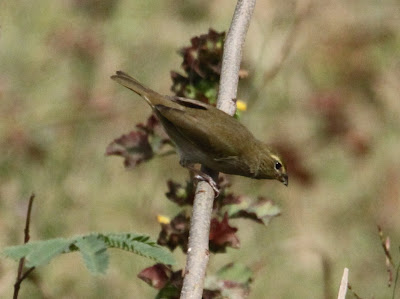My arrival back among the Caribbean
Islands was full of thoughts and hopeful expectations of returning
migrant birds to the United States and Canada. On the previous visits,
aboard the MV Voyager, to several Islands a fair number of these birds
were encountered but most in fairly dowdy, transitional and varying
stages of plumage, are we going to encounter the 'real McCoy' this time?
With solid reassurances of safety from Ernso I have now explored some of
the nearby

FOREST TRAILS
meeting some new mates
(The BIRD HUNTERS
who assure me they eat all they kill and so much reminded me of myself
during those uninformed years. Who am I to judge?)
and a few familiar ones, recorded on the last visit to the Island of Hispaniola,
which you may remember was
Santa Domingo, Dominican Republic
on the second day of the year.
Similar to that occassion the first on view was an 'endemic'
HISPANIOLAN WOODPECKER
but given the 'hunting' situation it felt unlikely that any 'lifers' would be seen?
I did have it in mind that 'one' would be nice but not very hopeful.
Otherwise, as you will see, the prospects look good.
Otherwise, as you will see, the prospects look good.
Next up and from the verandah of the house through pouring rain
a tiny Raptor which was approached as close as it would allow
and found to be a bedraggled
MERLIN
It wasn't long before the sun came out (along with some birds)
and the search could begin in earnest
with this fine looking fella,
perched on the wrought iron gate,
a male YELLOW-FACED GRASSQUIT
and not far away in the vegetation below was

MOTHER
DRAGONFLIES abound in the somewhat damaged forest,
but what remains is dense, full of fruiting trees and
Wot's That U There?
Surely the first of the 'YANKS'
and what a way to 'kick-off'
a pristine male
BLACK-THROATED BLUE WARBLER
seen many times before throughout the US,
but never in such close proximity.
but never in such close proximity.
Lots of these bright and very delicate
BUTTERFLY
preceded the next on parade, an equally obliging
male
COMMON YELLOWTHROAT
The 'pissssshing' was Working Wonders.
A cacophony of loud bird chattering had me back-tracking
to find this
A cacophony of loud bird chattering had me back-tracking
to find this
COMMUNAL NEST
of a COLONY of
another previously seen Hispaniolan 'endemic'
PALMCHAT
The National Bird of the Dominican Republic, it is of the family
Dulidae of which it is the only member. The 'manual' notes,
"probably more related to the Waxwings than any other Passerine
being arboreal, noisy and gregarious to the point of
'communal nesting".
Plenty of LIZARDs, of a number of species, were seen before this
female
COMMON YELLOWTHROAT put in an appearance
along with what I have dubbed
'EMERALD' DRAGONFLY,
SMOOTH-BILLED ANI
A LIZARD seemingly with 'more ambition
and the next Warbler.
Far more numerous than any other of the 'family' group
in all it was estimated that easily 30
NORTHERN PARULA
were recorded.
PALMCHAT
obviously keeping their young well supplied with the
abundance of fruit.
and finally, the LOCAL GOAT/SHEEPHERD (center)
who I now see on a daily basis and despite the
language difficulties seem to get along with very well.
Gratis 'Goat's Head Soup' in the future maybe?
who I now see on a daily basis and despite the
language difficulties seem to get along with very well.
Gratis 'Goat's Head Soup' in the future maybe?



















































